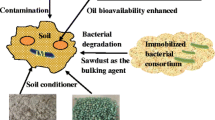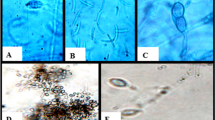Abstract
Bioremediation of trinitrotoluene (TNT)-contaminated soil has proven difficult due to the low bioavailability of the contaminant and its resistance to biocatalytic attack, causing slow rates of biodegradation. We have previously described a mixed bacterial culture acclimated and maintained on crude oil-containing medium that is capable of high rates of TNT biotransformation activity with low production of metabolites. We investigated the ability of this culture to bioremediate TNT-spiked soil and artificially weathered soil slurry systems, as well as a soil box system. The culture was able to remove up to 302 ppm (mg/l) of TNT within 24 h in a spiked-soil slurry system, which is among the highest rates of TNT removal reported to date. The toxicity of artificially weathered TNT-spiked soil to Vibrio fischeri decreased over a period of 39 h from a 15-min EC50 of 15.7 to 32.5 ppm. Preliminary results of a soil box system, in which no agitation was used, showed similar TNT removal to the soil slurry system, with 100 ppm TNT being removed within 24 h.
Similar content being viewed by others
References
Achtnich C., Sieglen U., Knackmuss H.-J. and Lenke H. (1999). Irreversible binding of biologically reduced 2,4,6-trinitrotoluene to soil. Environmental Toxicology and Chemistry 18: 2416–2423
Ahmad F. and Hughes J.B. (2002). Reactivity of partially reduced arylhydroxylamine and nitrosarene metabolites of 2,4,6-trinitrotoluene (TNT) toward biomass and humic acids. Environmental Science and Technology 36: 4370–4381
Alexander M. (1999). Biodegradation and Bioremediation. Academic Press. ISBN 0120498618, New York, NY
Boopathy R. (2000). Bioremediation of explosives contaminated soil. International Biodeterioration and Biodegradation 46: 29–36
Boopathy R. (2002). Effect of food-grade surfactant on bioremediation of explosives-contaminated soil. Journal of Hazardous Materials 92: 103–114
Boopathy R., Wilson M., Montemagno C.D, C.F. and Kulpa C.F. (1994). Biological transformation of 2,4,6-trinitrotoluene (TNT) by soil bacteria isolated from TNT-contaminated soil. Bioresource Technology 47: 19–24
Breitung J., Bruns-Nagel D., Steinbach K., Kaminski L. and Gemsa D. (1996). Bioremediation of 2,4,6-trinitrotoluene-contaminated soils by two different aerated compost systems. Applied Microbiology and Biotechnology 44: 795–800
Brinch U.C., Ekelund F. and Jacobsen C.S. (2002). Method for spiking soil samples with organic compounds. Applied and Environmental Microbiology 68: 1808–1816
Dave G., Nilsson E. and Wernersson A.-S. (2000). Sediment and water phase toxicity and UV-activation of six chemicals used in military explosives. Aquatic and Ecological Health Management 3: 291–299
Dodard S.G., Renoux A.Y., Hawari J., Ampleman G., Thiboutot S. and Sunahara G.I. (1999). Ecotoxicity characterization of dinitrotoluenes and some of their reduced metabolites. Chemosphere 38: 2071–2079
Duque E., Haidour A., Godoy F. and Ramos J.L. (1993). Construction of a Pseudomonas hybrid strain that mineralizes 2,4,6-trinitrotoluene . Journal of Bacteriology 175: 2278–2283
El-Alawi Y.S., Dixon D.G. and Greenberg B.M. (2001). Effects of a pre-incubation period on the photoinduced toxicity of polycyclic aromatic hydrocarbons to the luminescent bacterium Vibrio fischeri. Environmental Toxicology 16: 277–286
Frische T. (2002). Screening for soil toxicity and mutagenicity using luminescent bacteria – a case study of the explosive 2,4,6-tinitrotoluene (TNT). Ecotoxicology and Environmental Safety 51: 133–144
Hatzinger P.B. and Alexander M. (1995). Effect of aging of chemicals in soil on their biodegradability and extractability. Environmental Science and Technology 29: 537–545
Hawari J., Beaudet S., Halasz A., Thibotot S. and Ampleman G. (2000). Microbial degradation of explosives: biotransformation versus mineralization. Applied Microbiology and Biotechnology 54: 605–618
Held T., Draude G., Schmidt F.R.J., Brokamp A. and Rais K.H. (1997). Enhanced humification as an in-situ bioremediation technique for 2,4,6-trinitrotoluene (TNT) contaminated soils. Environmental Technology 18: 479–487
Honeycutt M.E., Jarvis A.S. and McFarland V.A. (1996). Cytotoxicity and mutagenicity of 2,4,6-trinitrotoluene and its metabolites. Ecotoxicology and Environmental Safety 35: 282–287
Lenke H., Warrelmann J., Daun G., Hund K., Sieglen U., Walter U. and Knackmuss H.-J. (1998). Biological treatment of TNT-contaminated soil. 2. Biologically induced immobilization of the contaminants and full-scale application. Environmental Science and Technology 32: 1964–1971
Lenke, H., Achtnich, C. & Knackmuss, H.-J. 2000 Perspectives of bioelimination of polynitroaromatic compounds, In: J.C. Spain, J.B. Hughes, & H.-J. Knackmuss (Eds.), Lewis Publishers, Boca Raton, FL. ISBN 1566705223
Lewis T.A., Ederer M.M., Crawford R.L. and Crawford D.L. (1997). Microbial transformation of 2,4,6-trinitrotoluene. Journal of Industrial Microbiology and Biotechnology 18: 89–96
Montpas S., Samson J., Langlois E., Lei J., Piché Y. and Chênevert R. (1997). Degradation of 2,4,6-trinitrotoluene by Serratia marcescens. Biotechnology Letters 19: 291–294
Popesku J.T., Singh A., Zhao J.-S., Hawari J. and Ward O.P. (2003). High TNT-transforming activity by a mixed culture acclimated and maintained on crude oil-containing media. Canadian Journal of Microbiology 49: 362–366
Popesku J.T., Singh A., Zhao J.-S., Hawari J. and Ward O.P. (2004). Metabolite production during transformation of 2,4,6-trinitrotoluene (TNT) by a mixed culture acclimated and maintained on crude oil-containing media. Applied Microbiology and Biotechnology 65: 739–746
Rieger, P.-G. & Knackmuss, H.-J. 1995. Basic knowledge and perspectives on biodegradation of 2,4,6-trinitrotoluene and related nitroaromatic compounds in contaminated soil, In: J.C. Spain (Eds.), Plenum Press, New York. ISBN 1566705223.
Rodgers J.D. and Bruce N.J. (2001). Treatment methods for the remediation of nitroaromatic explosives. Water Research 35: 2101–2111
Scow K.M., Fan S., Johnson C. and Ma G.M. (1995). Biodegradation of sorbed chemicals in soil. Biodegradation 5: 93–95
Shen C.F., Guiot S.R., Thiboutot S., Ampleman G. and Hawari J. (1998). Fate of explosives and their metabolites in bioslurry treatment processes. Biodegradation 8: 339–347
Shen C.F., Hawari J.A., Paquet L., Ampleman G., Thiboutot S. and Guiot S.R. (2001). Explosive biodegradation in soil slurry batch reactors amended with exogenous microorganisms. Water Science and Technology 43: 291–298
Singh, A. & Ward, O.P. 2004 Biotechnology and bioremediation – an overview, In: A. Singh, & O.P. Ward (Eds.), Springer-Verlag, Berlin. ISBN 3–540–21020–2.
Steevens J.A., Duke B.M., Lotufo G.R. and Bridges T.S. (2002). Toxicity of the explosives 2,4,6-trinitrotoluene, hexahydro−1,3,5-trinitro−1,3,5-triazine, and octahydro−1,3,5,7-tetranitro−1,3,5,7-tetrazocine in sediments to Chironomus tentans and Hyallela azteca: low-dose hormesis and high-dose mortality. Environmental Toxicology and Chemistry 21: 1475–1482
Sunahara G.I., Dodard S., Sarrazin M., Paquet L., Ampleman G., Thiboutot S., Hawari J. and Renoux A.Y. (1998). Development of a soil extraction procedure for ecotoxicity characterization of energetic compounds. Ecotoxicology and Environmental Safety 39: 185–194
Taha M.R., Soewarto I.H., Acar Y.B., Gale R.J. and Zappi M.E. (1997). Surfactant enhanced desorption of TNT from soil. Water Air and Soil Pollution 100: 33–48
Urbanski T. (1983). Chemistry and Technology of Explosives. Pergamon Press, Oxford
Ward O.P. (1999). Influence of chemical surfactants on the biodegradation of crude oil by a mixed bacterial culture. Canadian Journal of Microbiology 45: 130–137
Ward O.P. (2000). Volatile hydrocarbon degradation by a mixed culture during growth on crude oil. Journal of Industrial Microbiology and Biotechnology 26: 356–368
Ward O.P. (2001). Physical and metabolic interactions of Pseudomonas sp.Strain JA5-B45 and Rhodococcus sp.Strain F9-D79 during growth on crude oil and effect of a chemical surfactant on them. Applied and Environmental Microbiology 67: 4874–4879
Odumeru J.A. and Ward O.P. (2000). Community dynamics of a mixed-bacterial culture growing on petroleum hydrocarbons in batch culture. Canadian Journal of Microbiology 46: 441–450
Wang C.-J., Thiele S. and Bollag J.-M (2002). Interaction of 2,4,6-trinitrotoluene (TNT) and 4-amino−2,6-dinitrotoluene with humic monomers in the presence of oxidative enzymes. Archives of Environmental Contamination and Toxicology 42: 1–8
Ward O.P. and Singh A. (2000). Biodegradation of oil sludge. Canadian Patent 2: 220–761
Ward, O.P. & Singh, A. 2004 Evaluation of current soil bioremediation technologies, In: A. Singh, & O.P. Ward (Eds.), Springer-Verlag, Berlin. ISBN 3–540–21101–2.
Ye J., Singh A. and Ward O.P. (2004). Biodegradation of nitroaromatics and other nitrogen-containing xenobiotics. World Journal of Microbiology and Biotechnology 20: 117–135
Yinon J. (1990). Toxicity and Metabolism of Explosives. CRC Press, Ann Arbor, Michigan
Author information
Authors and Affiliations
Corresponding author
Rights and permissions
About this article
Cite this article
Popesku, J.T., Singh, A., El-Alawi, Y. et al. Trinitrotoluene removal in a soil slurry and soil box systems by an oil-degrading mixed bacterial culture. World J Microbiol Biotechnol 22, 1075–1081 (2006). https://doi.org/10.1007/s11274-005-5452-1
Received:
Accepted:
Published:
Issue Date:
DOI: https://doi.org/10.1007/s11274-005-5452-1




